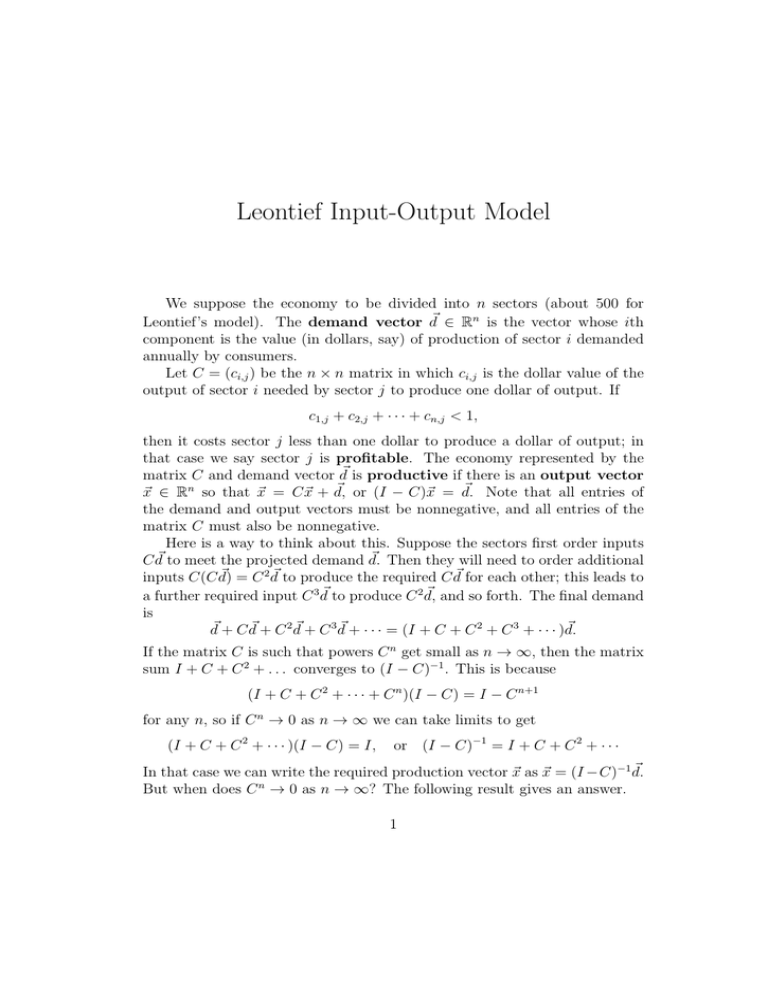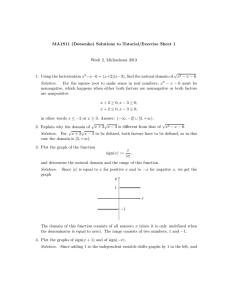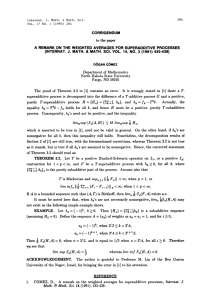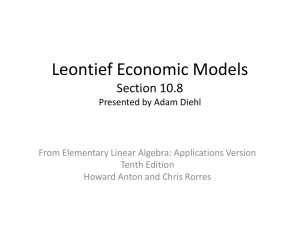Leontief Input-Output Model
advertisement

Leontief Input-Output Model We suppose the economy to be divided into n sectors (about 500 for Leontief’s model). The demand vector d~ ∈ Rn is the vector whose ith component is the value (in dollars, say) of production of sector i demanded annually by consumers. Let C = (ci,j ) be the n × n matrix in which ci,j is the dollar value of the output of sector i needed by sector j to produce one dollar of output. If c1,j + c2,j + · · · + cn,j < 1, then it costs sector j less than one dollar to produce a dollar of output; in that case we say sector j is profitable. The economy represented by the matrix C and demand vector d~ is productive if there is an output vector ~ or (I − C)~x = d. ~ Note that all entries of ~x ∈ Rn so that ~x = C~x + d, the demand and output vectors must be nonnegative, and all entries of the matrix C must also be nonnegative. Here is a way to think about this. Suppose the sectors first order inputs ~ ~ Then they will need to order additional C d to meet the projected demand d. ~ = C 2 d~ to produce the required C d~ for each other; this leads to inputs C(C d) ~ and so forth. The final demand a further required input C 3 d~ to produce C 2 d, is ~ d~ + C d~ + C 2 d~ + C 3 d~ + · · · = (I + C + C 2 + C 3 + · · · )d. If the matrix C is such that powers C n get small as n → ∞, then the matrix sum I + C + C 2 + . . . converges to (I − C)−1 . This is because (I + C + C 2 + · · · + C n )(I − C) = I − C n+1 for any n, so if C n → 0 as n → ∞ we can take limits to get (I + C + C 2 + · · · )(I − C) = I, or (I − C)−1 = I + C + C 2 + · · · ~ In that case we can write the required production vector ~x as ~x = (I −C)−1 d. n But when does C → 0 as n → ∞? The following result gives an answer. 1 Theorem 1. If C is a nonnegative matrix (that is, all its entries are nonnegative), then the following conditions are equivalent. 1. (I − C)−1 exists and is nonnegative; 2. C n → 0 as n → ∞; 3. There is a nonnegative vector ~x so that (I − C)~x is positive (that is, all entries of (I − C)~x are positive.) This has the following corollary. Corollary 1. If the nonnegative matrix C has all its row sums less than 1, then (I − C)−1 exists and is nonnegative. 1 1 Proof. If ~x = .. , note that the ith entry of C~x is just the ith column sum . 1 of C. But then C~x < ~x, so (I − C)~x > ~0. A slight twist to the preceding corollary gives a very natural result. Corollary 2. If the nonnegative matrix C has all its column sums less than 1, then (I − C)−1 exists and is nonnegative. Proof. Suppose C has all its column sums less than 1. Then by the preceding corollary, (I − C T )−1 exists and is nonnegative. But I is symmetric, so (I − C T )−1 = ((I − C)T )−1 = ((I − C)−1 )T ; and since the transpose of a nonnegative matrix is nonnegative, this means that (I − C)−1 exists and is nonnegative. Now the jth column sum of a consumption matrix being less than 1 says that sector j is profitable, so this latter corollary can be stated as follows. Corollary 3. An economy is productive for any demand vector d~ ≥ ~0 if each sector is profitable. Call a consumption matrix C productive if the economy represented by C and any demand vector d~ ≥ ~0 is productive. While Theorem 1 gives a necessary and sufficient condition for C to be productive, the condition that 2 there is some nonnegative vector ~x making (I − C)~x positive, or equivalently C~x < ~x, is not easy to check. (The hypotheses of Corollaries 1 and 2 are easy to check, but they may not be true.) So other criteria have been found. The following sufficient condition is called the Hawkins-Simon condition in the economics literature. Theorem 2. If C is nonnegative and every principal minor of I − C is positive, then (I − C)−1 is nonnegative. Another criterion can be given involving the eigenvalues of C. The Perron-Frobenius theorem states that if C is a nonnegative matrix, then there is a real eigenvalue λpf of C such that λpf ≥ 0 and |λ| < λpf for all other eigenvalues λ of C. We call λpf the maximal eigenvalue of C. Then the following result holds. Theorem 3. A nonnegative matrix C is productive if and only if the maximal eigenvalue λpf of C satisfies λpf < 1. To illustrate these three theorems, we shall take some examples of threesector economies. Remember that this is just for illustration, since any realistic input-output model has hundreds of sectors. First consider the economy with consumption matrix 0 .65 .55 C = .25 .05 .1 . .25 .05 0 Then C satisfies the hypothesis of Corollary 2, since every sector is profitable. But the hypothesis of Corollary 1 doesn’t hold, since the first row sum is 1.2. Since 1 −.65 −.55 I − C = −.25 .95 −.1 , −.25 −.05 1 has principal minors 1, 0.7875, 0.62875, the Hawkins-Simon condition is satisfied. The hypothesis of Theorem 3 also holds in this case, since C has maximal eigenvalue λpf ≈ 0.60174. On the other hand, the three-sector economy with consumption matrix .5 .15 0 C = .25 .15 .5 .25 .15 .5 3 fails to satisfy the hypothesis of Corollary 2; indeed sectors 1 and 3 are not profitable. But it does satisfy the hypothesis of Corollary 1, since the row sums are 0.65, 0.9, and 0.9. The hypothesis of Theorem 2 also holds, since .5 −.15 0 I − C = −.25 .85 −.5 −.25 −.15 .5 has principal minors 0.5, 0.3875, 0.1375. In addition, C has maximal eigenvalue λpf ≈ 0.78267, so the hypothesis of Theorem 3 is satisfied as well. Finally, consider .7 .3 .2 C = .1 .4 .3 . .2 .4 .1 This matrix violates the hypothesis of Corollary 2, since sectors 1 and 2 are not profitable. It also doesn’t satisfy the hypothesis of Corollary 1, since the first row sum is 1.2. With some persistence Theorem 1 can still be used to show C productive, since 2 1.9 2 C 1 = .9 < 1 . 1 .9 1 The principal minors of .3 −.3 −.2 I − C = −.1 .6 −.3 −.2 −.4 .9 are 0.3, 0.15, 0.049, so Theorem 2 implies that C is productive. Also, C has maximal eigenvalue λpf ≈ 0.92736, so Theorem 3 applies as well. But how can we show a consumption matrix is not productive? One way is by Theorem 3, but this requires knowing the maximal eigenvalue of C. We can at least get some information from row and column sums. As we’ve seen, C may still be productive even though individual row sums or column sums exceed 1. But what if, say, all the column sums of C are 1 or more? If C is productive, Theorem 1 implies that there is a vector ~x ≥ ~0 with c1,1 x1 + c1,2 x2 + · · · + c1,n xn x1 c2,1 x1 + c2,2 x2 + · · · + c2,n xn x2 C~x = < .. . .. . . xn cn,1 x1 + cn,2 x2 + · · · + cn,n xn 4 Adding these n inequalities gives (c1,1 + c2,1 + · · · + cn,1 )x1 + (c1,2 + c2,2 + · · · + cn,2 )x2 + · · · + (c1,n + c2,n + · · · + cn,n )xn < x1 + x2 + · · · + xn . But we’ve assumed that all the column sums c1,1 + · · · + cn,1 , c1,2 + · · · + cn,2 , ..., c1,n + · · · + cn,n are ≥ 1, so we have the contradictory inequality (c1,1 + c2,1 + · · · + cn,1 )x1 + (c1,2 + c2,2 + · · · + cn,2 )x2 + · · · + (c1,n + c2,n + · · · + cn,n )xn ≥ x1 + x2 + · · · + xn . This contradiction shows that C cannot be productive, giving us another corollary to Theorem 1. Corollary 4. The nonnegative matrix C cannot be productive if every column sum is 1 or more. To put it another way, an economy cannot be productive if every sector is not profitable. By taking transposes as above we also have the following result. Corollary 5. The nonnegative matrix C cannot be productive if every row sum is 1 or more. Exercises 1. Determine which of the following consumption matrices is productive. .5 .4 .2 .7 .3 .25 a. .2 .3 .3 b. .2 .4 .25 .3 .4 .4 .05 .15 .25 .1 .5 .4 .1 .1 .3 c. .4 .3 .3 d. .9 .8 .3 .3 .4 .4 .1 .5 .4 2. Give an example of a (nonzero) productive consumption matrix that is not invertible. 5 .7 .3 .2 3. For real numbers t ≥ 0, let C(t) = .1 .4 .3. For which t’s can you .2 .4 t say whether C(t) is productive or not? 6




